PLAN IN PLACE TO CAPTURE NAZI SECRETS
Wright Field, Dayton, Ohio · April 22, 1945
During the war Allied countries were keen to gain access to the products of German research and development. A British commando raid on a German radar installation on February 27–28, 1942, in occupied France convinced British scientists who analyzed the radar array that it was impervious to jamming by conventional means. The British therefore developed a low-tech countermeasure that we know today as chaff—the cloud of small, thin pieces of aluminum, metalized glass fiber, or plastic dropped by aircraft that swamps radar screens with multiple returns, baffling radar operators. The success of the July and August 1943 Allied bombing raids against the North German city of Hamburg was largely attributable to the capture and evaluation of German technology.
The U.S. Army Air Forces Intelligence Service created Air Technical Intelligence (ATI) teams tasked with acquiring items of interest recovered from German crash sites in liberated Europe. Trained at the Technical Intelligence School at Wright Field near Dayton, Ohio, ATI teams competed with at least 32 other Allied technical intelligence groups.
On this date in 1945, two weeks before the war in Europe ended, the USAAF Intelligence Service inaugurated Operation Lusty, an acronym for Luftwaffe Secret Technology. Lusty’s aim was to exploit captured German scientific documents, research facilities, and revolutionary weapons (Hitler’s “miracle weapons”). Intelligence experts such as “Watson’s Whizzers,” nicknamed after their chief, Col. Harold Watson, had long lists, called “Black Lists,” of advanced aviation equipment they wanted to examine and aircraft company employees, including pilots, they wanted to interrogate.
Evidence suggests that even before formally kicking off Operation Lusty some ATI teams had already penetrated Nazi Germany to fly out, hide, or otherwise remove “black listed” items to U.S.-controlled areas. Enemy aircraft such as the Messerschmitt Me 262 Schwalbe, the Arado Ar 234 Blitz, and the Heinkel He 162 Volksjaeger were flown (some by German pilots) to Cherbourg, France, and shipped to the U.S., where USAAF and Navy personnel poured over them. In all over 16,000 items were acquired, of which 2,398 were selected for technical analysis. Operation Lusty was responsible, in whole or in part, for many of the examples of German World War II aircraft that were preserved and are now on display at the Smithsonian’s National Air and Space Museum in Washington, D.C.
![]()
[amazon_carousel widget_type=”ASINList” width=”600″ height=”200″ title=”Recommended Reading” market_place=”US” shuffle_products=”False” show_border=”False” asin=”1782003681,1902109392,1618613383,1853675776,074725964X,0764340484,1906537127,1848326998,1473823390,1857802446″ /]
German Jet Aircraft of World War II
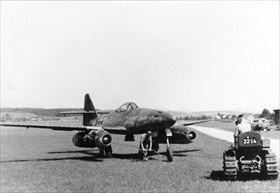 | 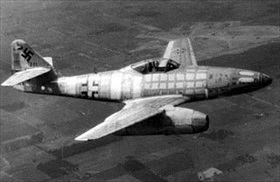 |
Left: The twin-engine Messerschmitt Me 262 Schwalbe (Swallow) was the world’s first operational jet-powered fighter aircraft. It was used in a variety of roles, including light bomber, reconnaissance, and even experimental night fighter. Roughly 1,400 Me 262s were produced, but no more than 200 were operational at the same time. Me 262s destroyed some 150 Allied planes (Me 262 pilots claimed a total of 542 Allied kills), but the Allies destroyed about 100 Me 262s in the air. In February and March 1945, Allied planes destroyed approximately 60 Me 262s in ground attacks.
![]()
Right: Pictured here was the first Me 262 to come into Allied hands when its test pilot defected in March 1945. It was subsequently lost in August 1946, the U.S. test pilot parachuting to safety.
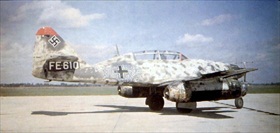 | 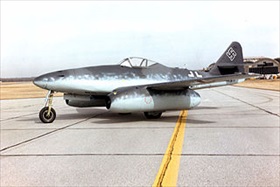 |
Left: Captured by the British, this Messerschmitt Me 262 B‑1a/U1, originally built was a jet trainer, was converted by the Luftwaffe into a night fighter. Later the jet was transported to the U.S. for testing and evaluation in 1946.
![]()
Right: A Messerschmitt Me 262A on display at the National Museum of the United States Air Force, Wright-Patterson Air Force Base, Dayton, Ohio. “Watson’s Whizzers” flew at least 10 captured Me 262s to Cherbourg, France, in June 1945. At this French seaport, 35 advanced enemy aircraft were loaded onto a U.S.-bound aircraft carrier the British made available.
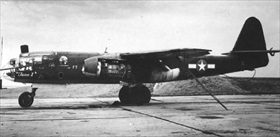 | 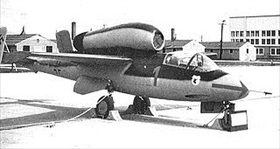 |
Left: Slightly faster but less famous than the Messerschmitt Me 262 was the Arado AR 234 Blitz (Lightning), the world’s first operational jet-powered reconnaissance/bomber. Produced in very limited numbers (total production was 224 of all versions), the Ar 234 was used almost entirely in a reconnaissance role—flying unscathed, for example, over the Allies’ Normandy invasion beaches on a photo-reconnaissance mission. In its few uses as a bomber it proved to be nearly impossible to intercept, though one Ar 234 bomber was brought down over the newly constructed floating engineer bridge at Remagen (replacement for the collapsed Ludendorff Bridge) in a clever maneuver by a P‑47 Thunderbolt fighter pilot. The photo above shows the Arado 234B‑2 bomber with U.S. markings back in the States following its capture by British forces in Norway in 1945.
![]()
Right: A captured Heinkel He 162 Volksjaeger (People’s Fighter) sits on the tarmac in Cherbourg, France, where it awaits transport to the States. Made primarily of wood (metal being in short supply), the He 162 was a sleek single-engine, jet-powered fighter aircraft and was the fastest of the first-generation World War II jets. By war’s end on May 8, 1945, 120 He 162s had been delivered to the Luftwaffe. A further 200 had been completed and were awaiting collection or flight-testing, and about 600 more were in various stages of production.
Wings of the Luftwaffe: Arado Ar 234 Blitz (Skip first minute)
![]()

 History buffs, there is good news! The Daily Chronicles of World War II is now available as an ebook for $4.99 on Amazon.com. Containing a year’s worth of dated entries from this website, the ebook brings the story of this tumultuous era to life in a compelling, authoritative, and succinct manner. Featuring inventive navigation aids, the ebook enables readers to instantly move forward or backward by month and date to different dated entries. Simple and elegant! Click
History buffs, there is good news! The Daily Chronicles of World War II is now available as an ebook for $4.99 on Amazon.com. Containing a year’s worth of dated entries from this website, the ebook brings the story of this tumultuous era to life in a compelling, authoritative, and succinct manner. Featuring inventive navigation aids, the ebook enables readers to instantly move forward or backward by month and date to different dated entries. Simple and elegant! Click 











